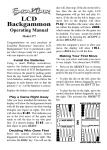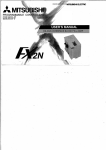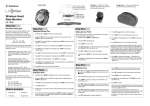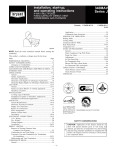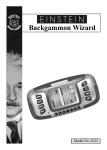Download Excalibur 366 User manual
Transcript
BACKGAMMON (366E-2) USER MANUAL ENGLISH Thank you for purchasing your Excalibur computer backgammon game. With proper care it should provide years of reliable entertainment and challenge. 1 Getting Started Your Backgammon Computer is powered by 4 “AA” batteries. Install them in the compartment on the underside of the computer, making sure that the positive tip of each battery matches up with a + sign in the compartment. You may purchase the optional Excalibur AC Adapter direct from the factory or your dealer. If you choose to use your own, you must make sure that it is 6V 100 Ma or else you will damage your computer. In the Liquid crystal display (LCD) you should now see: ❑ ❑ r o l l Occasionally after inserting new batteries or connecting an adapter the computer may act abnormally. Push a thin object into the “Reset” hole in the base of the computer and press down once to reset your game. 2 Your Move; Rolling Dice THE COMPUTER ALWAYS PLAYS BLACK The word roll shows that the computer is ready for the dice to be rolled at the start of a game. You may roll your own dice by entering their value on the die keys, or you may have the computer roll the dice by pressing ROLL DICE. If you use the computer to roll your dice, then the computer will automatically roll it’s dice when it is it’s turn. If you switch to manual entry on your move, the computer will then wait for you to enter the dice when it is it’s turn. At the start of the game, the die on the left of the LCD is red’s die and is used to determine who goes first. If it is greater than black’s die on the right WHITE goes first. If doubles are rolled, the machine displays “doub” asking if you want to double the games value. Press ACCEPT for yes and DECLINE for no. Pressing Decline will not cause you to forfeit the game. The cube holder is not affected by this doubling, so neither player has the cube. Press the key marked ROLL DICE. The computer simulates the throw of the dice and then displays the two numbers it has “rolled” in the left hand part of the LCD, for example: 3 2 PLAY The 3 indicates that red goes first, and that the human player will play the 3 2. Suppose you want to move a man from the 13 point to the 10 point. Press down with one of the men on the 13 point. The computer beeps, and the number 13 appears in the display window. If the move does not appear to have registered, press down with the edge of the piece. Place the men on the backgammon board as shown above. Note that the “Points” on the board are numbered in a single sequence from 1 to 24. The red men move towards the points numbered 1; the gray men move in the direction of the 24 point. You will find a pair of dice supplied with your backgammon computer. One way of playing is to roll the dice by hand and enter the numbers into the computer. For the moment, however, we assume that you want the computer to roll the dice electronically. 2 Move your man to its destination, the 10 point and press it down on that point. The display will then only show the 2 die for you to play. Now carry out your move with the smaller number, pressing down on the “From” and “To” points as before. For example, you may press the 10 point and move the man to point 8. Once you have completed your move the dice will automatically roll for the computer. The display will show the “From” and “To” locations for the computer with the black square symbol indicating it is the computers move. Move the pieces for the computer as indicated in the LCD in the same way as before. The display will now show ❑ ❑ roll. 3 Once you have completed the computers turn you must then press ROLL DICE to see the dice for your next turn. Of course, if a double is rolled (by either side), you will normally carry out the move in four parts instead of two. For easy move entry, the computer has been programmed to recognize entering a move using both die at the same time. Simply enter the source and the final destination for your piece. If a hit is involved, DO NOT USE this feature. Make sure you hit the computers point, and don’t jump over it. Therefore you could move a roll of 32 in one stroke as follows: Press point 13 and end your turn at point 8. Hitting A Blot Offering A Double The backgammon computer allows the score to be doubled as though you were raising the stake with a doubling cube up to a maximum value of 64. To inspect the current value of the cube, press the CUBE key. The white cube indicates that you have ownership of the cube. If the cube is dark then the computer has ownership of the cube. Press the DOUBLE / ACCEPT key to offer a double to the computer. If the computer accepts the display will show ROLL. If the computer declines the display will show LOSS. The game will then be over. If the computer is asking you to double the display will read doub. To accept press the DOUBLE / ACCEPT key. To Decline press the DECLINE key. If you decline the game will end and you will be scored a loss for that game. If a man of either color hits a blot (opposing piece), you will see the symbol b A on the right side of the display with the piece location number on the left indicating the piece that has been hit. You must then move that piece to either of the two BAR locations in the center of the board, remembering to press the captured piece down first on its original location. Once you have pressed the sensor under the Bar symbol the turn is completed. When bringing your man back in from the bar, simply press the BAR area followed by the “To” point. If the player on the Bar rolls two numbers that cannot be played, then the display will indicate PASS. New Game Bearing Off Levels of Skill To “Bear off” one of your men, simply press it down on its point, transfer it to the BEAR OFF area, and press down with it again. You can then remove that man from the board. When the computer is moving it will indicate bE in the display when the computer wants to “ bear off” a piece. Your backgammon computer has 8 levels of skill. Level 1 is the weakest and is designed for the beginner player. The strongest level is level 8 and is designed for the tournament player. The computer weighs the higher levels with a higher score value for your rating. If you lose a game on level 1 you will lose more points than a loss on level 8. You can begin a new game at any time. Just press the NEW GAME key. If you press a new game before the computer has begun to bear off its men, the scoring feature will not be effected. You therefore have the ability to protect your rating by cheating if you are off to a bad start. But, if the computer has already one or more pieces already cast off, the computer will assume you are resigning and will score the game as a loss for you and then update the score and rating. Errors A valid press on a key or point produces a high toned beep. An incorrect press produces the error signal - a low buzz. After an error signal simply continue by pressing the correct key or point. Or you may press the clear button to start again. If you press a man on its “ From” point but decide not to move it after all, press it down a second time. The number of this point will be cleared from the LCD. The display will now show PLAY and you can now move any man you like. 4 The level may be checked or changed at any time at the beginning of your turn. Press the key marked LEVEL, and the current level will appear in the display, for example: LE 8 You can now change the level by re-pressing the LEVEL key. Each press increases the level by 1. When the display shows the level you desire, just press the Clear Key. 5 Verifying the Position In case of confusion you can check where all the men on the board should be, according to the computer’s memory. This is possible at any time when it is the start of your turn. Press the key marked VERIFY, and the display will show the quantity of pieces on each occupied square. The first number in the display will be the piece location and the second number will be the quantity of pieces at that location. The white square will indicate your pieces and the computer pieces will be identified by a dark square. Example: 02 4 This indicates that there are 4 men on point number 2. Taking Back moves Sometimes, after you have completed your move on the board, you realize that it was a mistake and would like to take it back. You may do so, even if the computer has already made its reply move. To take back your move press the key marked TAKE BACK display will now show the “From” and “To” points of a man you have just moved. Now play your previous moves in reverse. To take back the computers move simply press take back again and retract the computers moves as described in the display. Once you have taken back the move just press ROLL DICE to make your next new move. This feature allows you to take back up to 2 moves. If you are using the auto dice roller, you have to take back the computers move first then yours. Memory If a game has to be interrupted, press the OFF/SAVE key. You can do this anytime as long as it is the start of your turn and you have completed the computers last move. The computer then switches off, but will still retain the current position in its memory for while using a minimum of current. The game will be stored for the life of your batteries which can be up to several months. If you remove your batteries from your game or press the ACL you will reset all stored memory and scores on your computer. When you press ON/RECALL, the computer switches on and the position is just the same as before. You may wish to verify the position before you continue play. Identification of Keys total for the cube for all games you have played. Pressing this key a second time will result in your rating being displayed. Rating score evaluation are as follows: 500 to 1000 1001 to 1500 1501 to 2000 2001to 2200 2201 and up Beginner Intermediate Advanced Expert Champion On level 8, the machines rating is assumed to be 1536. On level 1 the computer’s rating is assumed to be 640. The computer recomputes your rating after every game depending on the level, cube value, and your established rating before the game. At the end of a game you can have your new rating and score displayed once you have pressed NEW GAME. WON [games] This key displays the number of games you have won. PLAYED [games] This key shows the number of games you have played. GAMMONS This key shows the number of Gammons you have made against the computer. Pressing more than once will show the number of Gammons the computer has made. BACKGAMMONS This key shows the number of Backgammons you have made against the computer. Pressing it once more will show you the number of backgammons the computer has made. ROLL DICE You press this key to have the computer roll the dice for you. Please note that your computer uses a random roll generator to roll the dice. Even though sometimes it may seem that some combinations of rolls may seem bizarre, every roll is random. The computer will never cheat on the dice roll. If you do not like the random roller then you are free to use the dice included with your game. SCORE - Pressing this key once will show you a white box and your score. This score can be negative if you have lost more points than the computer. The maximum score is 999 and the lowest score is -999. This score is the 6 7 OFF/SAVE This key is used to turn your computer off and to save your game in memory. CUBE At the start of the game, this key may be used to turn Off or On the doubling cube feature. It will also give you the Cube value during the game. DECLINE This key is used to decline the doubling offer by the machine or, if doubles are rolled at the start, to not have the stakes doubled. DOUBLE/ACCEPT This key is used to double the opponent ( will work in Multi-Move) if the display shows no one has the cube, or the cube is held by the player on the move. while in Multi-Move. This is also known as monitor mode where the computer acts as a referee. VERIFY Pressing this key repeatedly will allow you to check what is on every point, bar and bear off. CLEAR Use this key to clear an undesired source point. You may also press on the source point again, to clear the selection or see takeback for clearing an already entered move. ACL Is located on the bottom of your game. Use this button if the unit does not seem to be responding. If unit still is not operating correctly, insert new batteries. HOW TO PLAY BACKGAMMON ON/RECALL This key is used to turn your computer on or to recall a game saved in memory. The Board and it’s Arrangement LEVEL This key is used to select 1 of 8 skill levels, where 8 is the highest. Backgammon is a game for two players, played on a board with men of two different colors, usually red and black. In the diagrams of the backgammon board in this instruction manual the red men appear as the wire circles. HINT This key is used to have the computer give you a hint to help with your play. When it is your turn and after the dice have been entered press to look at a hint. Press a second time to look at the second half of the hint move, or a third and fourth time if doubles have been rolled. You make now make that move or press hint again to allow you to make your own different move if you do not like what the computer has offered. Here you can see the arrangement of the backgammon board, set up for a new game. TAKE BACK This key is used to take back your last move if you have made a mistake. NEW GAME This key is used to reset your game and to start a new one. Pressing NEW GAME will generally start the game over with no action on score or rating. The board is rectangular and is divided into two halves by a bar. Each numbered triangle on the board is called a point The six points numbered 16 are know as red’s inner table or home board and those numbered 19-24 are known as Black’s inner table or home board. MULT-MOVE Pressing this key turns the colon ON or OFF. When ON, this feature can be used to play another person using the computer to roll dice and check for legal moves. The computer will also update the scores but Not the rating Each player begins the game with 15 men. In the course of play he moves his own men around the board from point to point in the direction of his own inner table, as indicated by the arrows in the diagram. The red men move 8 9 clockwise, the black men move counter-clockwise. RESTRICTIONS ON PLAY The Start of Play A) A player may only move a man to a point which is: In a game between two human players each player normally rolls one die to determine who starts. The player who rolls the higher number makes the first move - if they both roll the same number they must roll again. It is therefore impossible for the very first roll played in a game to be a double. At this time, if the doubling cube is being used, the point value may double. 1) vacant, 2) already occupied by one or more of his own men, or 3) occupied by a single enemy man. In a game between two human players, on the first move of the game the player moves his men according to the two numbers rolled by himself and his opponent. At the start of each subsequent move, the player rolls both dice himself. His choice of moves is determined by the numbers that appear on the dice when they are rolled. In the case of (3) the enemy man is removed from the point and placed on the bar - see the section below on Hitting an Enemy Man (or Blot) If a player has two or more men on a point, then he is said to have made that point , and his opponent’s men may not land on it. For this reason, it is a good idea to try to make a number of points that are adjacent to each other, since this will impede the progress of your opponent’s men around the board, and will often leave him with no way to use all or part of his roll. Once a game has begun the players take turns to move. Making Ordinary Moves There are no limits to the number of your own men that can occupy a point at any one time. If the player’s roll of the dice results in a mixed roll such as 3-5 or 6-1, then he moves one of his men the number of steps indicated by one of the dice, and another of his men (or the same man) the number of steps indicated by the other die. b) If a man may move, he is obliged to do so. He cannot pass c) A player must, if possible, play both parts of his role. As an example, let us see what happens if red rolls a 6-1 in the following position. Here red moves first, and the roll is 3-1. There are many ways to play this roll. DIAGRAM OF THE INITIAL POSITION One way is to move a man one space from the 6 point and then another man 3 spaces away from the 8 point. Then both these men will be occupying the 5 point. By moving the man one step from the 10 point red would leave himself unable to move either man six steps because of the two black blockades . So this particular play is illegal because there is an alternative play in which red uses both the 1 and the 6 he may move his man from the 20 point to the 19 point and then move either man six steps. This play makes use of use of both the one and the six. d) If it impossible to use both parts of a roll a player must, if possible, use the higher 10 11 part. So, if rolling a 3-2 gives the player a choice of only moving a man 3 steps or only moving a man 2 steps he must chose a play that moves a man three steps. If a player Cannot move Any of His Men If a player is unable to use any of his dice roll to move any of his men, then he must pass and it is his opponent’s turn again. Hitting an enemy man (or Blot) If a point is occupied by one enemy man then that man is called a blot and is vulnerable. If one of your own men lands on it while making a move, then the enemy blot is removed from that point and placed on the bar in the center of the backgammon board. This process is called hitting a blot . If Red now moved two steps from the 9 point he would then be prevented from moving three steps because of the blockade on the 4 point. But Red may move this man three steps, from the 9 point to the 6 point, even though he will then be able to move it two steps because of Blackís blockade. The reason is that he has used the higher part of the roll - the three rather than the two. Rolling a Double If a player’s throw of the dice results in a double such as 2-2 or 5-5, he must (if possible) make four moves of the indicated number of steps. For example, if he rolls a 2-2 a player may move four different men two steps each, or he may move one man two steps and then another two steps and another and another, or he may choose some combination such as moving one man two steps, and another man two steps on three successive hops. Here black has rolled a 5-5. He can move his last remaining man four hops each of four steps. Reentering the Board from the Bar Once a player has one or more men on the bar he must bring that man (or those men) back into play before moving any of his other men. Men on the bar re-enter the game in the opposing player’s inner table. So a red man on the bar can only re-enter play on one of the points numbered 1924: rolling a 1 allows red to enter on the 24 point, rolling a two allows him to enter on the 23 point, rolling a three means the 22 point, and so on. A black man on the bar can only re-enter play on one of the points numbered 1-6(the same number corresponding to the dice roll). If the man re-entering the game from the bar hits an enemy blot, then the enemy blot is sent to the bar. Here red has a man on the bar. If he rolls a 3-3 he cannot come in off the bar because Black has made the 22 point. With any other roll Red can come off the bar. And if part of the roll is a roll is a 5 red can hit the black blot. Having used part of a dice roll to re-enter a man from the bar, a player may then use the rest of the dice roll to re enter another man, or, if that is not necessary, to continue with the game in the normal manner. 12 13 If a player rolls a double while he has one or men on the bar, he uses all four parts of the roll in the usual way, provided of course that he re-enters any men still on the bar. If black rolls 4 and 3, he uses the 4 to bear off a man from the 22 point (which is opposite to the 3 point) or to move a man from the 21 point to the 24 point. A red man may also be borne off by using a dice number that is higher than the number occupied. This is only possible, however, if red has no other man to the right of the man being borne off., i.e. no men on higher numbered points. Here Black has a man on the bar and has rolled 4-1. Black must move his man off the bar before he moves another man, but coming in off the bar is not possible with a four (or with a 2,3,5 or 6) because red has made all these points. So black must come in with the 1 and use the four to move another man. BEARING OFF MEN In this example, if red rolls 5 and 4, he bears off two men from the three point. The object of the game is to move all of your men around the board and into your inner table, and then to bear them off , i.e. remove them from the board. You are not allowed to start bearing off until all your men are in your inner table. In the same example, if black rolls 6 and 5, he bears off 2 men from the 21 point. The minimum roll required to bear a man off from this point would be 4, but Black may use a higher number for this purpose when he has no other men on lower numbered points. The player with Red may bear a man off when he rolls the same number as the point on which the man is located. The player with black may bear a man off when he rolls the number of the point opposite to his own man. If he prefers, a player may also use all or part or all of his roll to move men in the board rather than to bear men off. In this example, suppose red rolls 6 and 2. He must use the six to bear off a man from the 6 point. He may use a 2 to bear off a man from the 2 point ( but if he prefers he may instead move the man from the 6 point to the four point. In this position, notice that if red rolls 6 and 3, he has two options. He may bear off two men (from the 6 and the 3 points), or he may move his man from the 6 to 3 and then bear off one man from the 3 point. (In the latter case he is not making the maximum use of the pips on the dice, but 14 15 is still complying with the rules because he is using both numbers rolled.) If a player’s blot is hit after he has started bearing off, he must re-enter from the bar and reach his own inner table again before continuing to bear off. REMEMBER: You are only allowed to bear a man off the board if all of your remaining men are in your inner table. Who Wins? The game is won by the first player who bears off all his own men. Another way to win a game is by your opponent’s resignation. He may only resign when you offer to double. (See the section on the doubling cube, below.) the next highest face uppermost. This offers to double the stakes . The first player to offer a double would turn the 2 uppermost. His opponent must now decide whether or not to accept the double. If the opponent accepts the double then the game continues but the stake is now 2. If the opponent does not want to play for double the stake, he may decline the double and hereby resign the game, losing 1 point. A player who accepts a double keeps the cube on his side of the board. He is now the only player who has the right to make the next double. If he does decide to offer a double, making the stake 4, his opponent may either accept the double or resign the game and lose 2 points. If the double is accepted. the cube now shows 4 and moves over to the other side of the player who accepted this latest double. Once the value of the cube reaches 64, there may be no more doubles. Scoring AT THE END OF THE GAME The number of points scored when a player wins a game depends partly on how much progress his opponent has made and partly on the status of the doubling cube. (see below.) If the loser has managed to bear off at least one man, then the winner’s basic score is one point. If the loser has not managed to bear off any men but does not have any of his own men in the winner’s inner table or on the bar, then the winner’s basic score is 2 points. This situation is called a Gammon . If the loser has not managed to bear off any men and has at least one man on the bar or in the winner’s inner table, then that winner has a Backgammon and his basic score is 3 points. The winner’s basic score is then multiplied by the status of the doubling cube to obtain the actual number of points scored. THE DOUBLING CUBE At the end of the game the basic score, (1 point for a simple win, 2 points for a Gammon or 3 points for a Backgammon) is multiplied by the final value of the doubling cube in order to work out the winner’s score. TO ENSURE PROPER FUNCTION: Do not mix old and new batteries Do not mix alkaline, standard or rechargeable batteries Do not use rechargeable batteries Battery installation should be done by an adult Only batteries of the same or equivalent type as recommended are to be used Batteries are to be inserted or removed from the battery compartment at the base of the unit Batteries are to be inserted with the correct polarity Exhausted batteries are to be removed from the toy The supply terminals are not to be short-circuited Use of the doubling cube can make the game much more exciting. The cube has it’s faces numbered 2,4,6,8,16,32 and 64. At the start of the game the cube is in the middle (and usually shows the number 64 to indicate that it has not yet been used). It does not have any effect at this stage. Before he rolls the dice to make a move the player may pick up the doubling cube (provided that it is in the middle or on his side ), and turn 16 17









